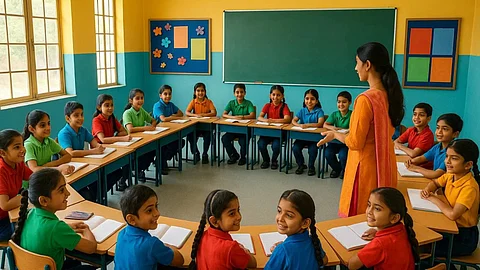

In recent days, revolutionary classroom design gaining popularity in Indian education system. In a significant transformation of classroom environments, schools in Kerala are discarding conventional row seating in favour of a semi-circular or U-shaped layout, inspired by the 2024 Malayalam film ‘Sthanarthi Sreekuttan’. This progressive seating arrangement promotes inclusivity and fosters equal engagement among students by eliminating the ‘backbencher’ stigma. The initiative has already seen adoption in at least eight schools in Kerala and one in Punjab, with Telangana educational authorities, particularly in Hyderabad, beginning to implement U-shaped benches following directives from the district collector.
Reshaping Classrooms: Kerala Takes the Lead
The innovative seating inspired by ‘Sthanarthi Sreekuttan’ situates students in a semi-circle or along classroom walls, placing the teacher at the center. This arrangement ensures all students are visible and accessible, breaking down traditional hierarchies in which diligent students sit at the front and others remain at the back. The initiative mirrors the spirit of the District Primary Education Programme (DPEP) initiated by the Central Government in 1994, revitalized by the film's narrative. Notable schools adopting this model.
Director Vinesh Viswanath, making his debut with ‘Sthanarthi Sreekuttan’, expressed his joy at the film's real-world impact, noting that six schools have already implemented the arrangement after being tagged in posts on social media. The idea, born from a scene in which a seventh-grade student advocates for the U-shaped configuration to overcome the stigma of being a backbencher, has ignited a grassroots movement. Veteran teachers have reported that this layout enhances student involvement and fosters direct interaction, cultivating a more inclusive classroom atmosphere. Furthermore, some of the students also have highlighted improved visibility of the blackboard and greater concentration during lessons.
Telangana Follows U-Shaped Seating
Building on Kerala's success, schools in Telangana are beginning to swap traditional seating for U-shaped arrangements. On July 15, 2025, Hyderabad District Collector Hari Chandana Dasari directed schools to eliminate back benches in favour of U-shaped setups, particularly to promote engagement among marginalized communities. During her visit to the Tribal Welfare Ashram Boys School in Bowenpally, she pointed out that traditional back benches often keep students distanced from teachers, hindering engagement. “For every child to participate in learning, classrooms must be arranged in a U-shape, abolishing back benches altogether,” she declared. This directive aligns with broader educational reforms in Telangana aimed at improving learning outcomes through digital classrooms and the TSAT platform.
Screen to School: Wider Impact on Educational System
The push for U-shaped seating is expanding beyond Kerala and Telangana. On July 12, 2025, Tamil Nadu's Education Department announced a pilot program for implementing this seating arrangement in middle schools. Likewise, a school in Punjab decided to adopt the U-shaped model after its principal enjoyed ‘Sthanarthi Sreekuttan’ on the Saina Play OTT platform and subsequently showcased it to students to highlight its educational values. In Karnataka, child rights activists are encouraging their state government to follow suit, advocating for the model's potential to foster equality and address the stigma associated with being a backbencher.
How ‘Sthanarthi Sreekuttan’ Tackles the Issue?
Directed by Vinesh Viswanath, ‘Sthanarthi Sreekuttan’ is a heart-warming coming-of-age Malayalam film set in K R Narayanan Upper Primary School in Thiruvananthapuram. Released in theaters on November 29, 2024, and later available on Saina Play, the film chronicles the antics of four students, centering on Sreekuttan, a quiet backbencher. Alongside actors like Aju Varghese and Johny Antony, the narrative delves into the social and academic divides inherent in classroom structures. In the climactic moments of the story, ‘Sthanarthi Sreekuttan’ advocates for a U-shaped seating arrangement during a school election campaign to push for equality, drawing from his own feelings of being overlooked. Originally conceptualized as a comedic short film, it evolved into a feature film rich with emotional depth, inspired by progressive classroom models in some other countries.
Beyond the Big Screen: Changes Begin
The film's influence on India's educational landscape is significant, challenging the entrenched frontbencher-backbencher hierarchy and revitalizing discussions around classroom inclusivity. The U-shaped seating model cultivates a democratic learning environment in which every student becomes a "frontbencher," minimizing psychological barriers and encouraging peer engagement. Educators have noted increased student participation and enhanced teacher-student relationships, particularly in smaller classes. Supporting studies revealed that 77% of students found U-shaped seating to be comfortable and conducive to engagement.
However, the transition is not without its challenges. Critics, particularly experts from the medical & health field have raised concerns about potential ergonomic issues from prolonged sideways seating in larger classrooms. Additionally, government schools with limited resources may face challenges in implementing the U-shaped design due to the need for investment in suitable furniture and space.
Despite these obstacles, the initiative has attracted praise from figures like Anand Mahindra, who called it an "intriguing experiment" on social media, and has evoked nostalgia among those who appreciate the backbencher culture as a space for creativity and independence.
A Nationwide Movement Emerges
The U-shaped seating reform, ignited by ‘Sthanarthi Sreekuttan’, exemplifies the profound power of art to inspire change. With schools across Kerala, Telangana, Tamil Nadu, Punjab, and potentially Jammu and Kashmir adopting this model, a shift towards more inclusive and student-centered educational practices is underway. This movement aligns with global best practices seen in countries like Finland and Norway, mirroring India's ongoing efforts to modernize its educational framework. As Vinesh Viswanath remarked, “It is heartening to see our cinematic message translate into tangible change.” With growing national enthusiasm, this classroom revolution has the potential to reshape how Indian students learn and interact for generations to come.
